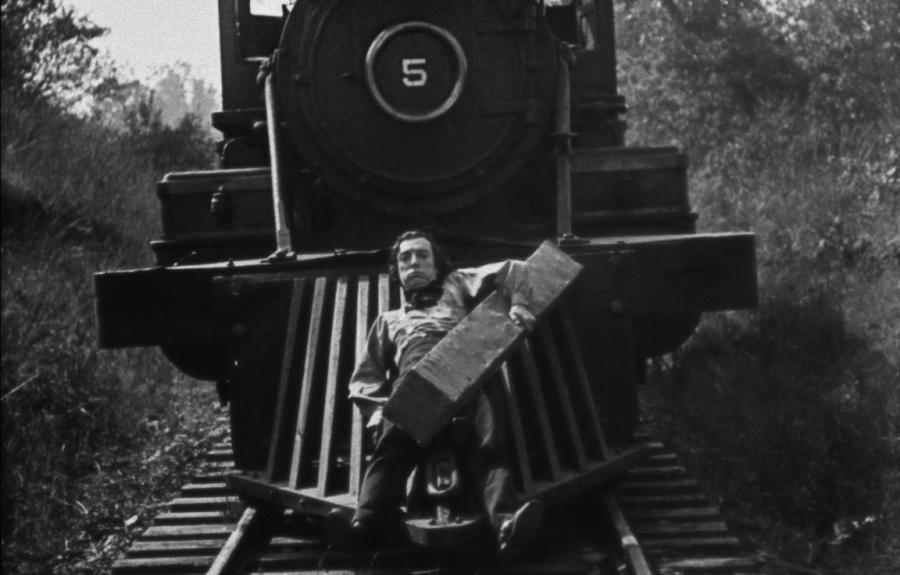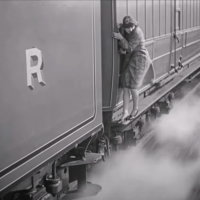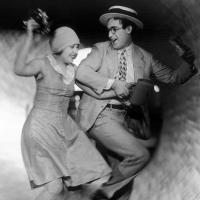Film series: Off the Rails! Trains in Silent Cinema

In honor of Silent Movie Month in Ithaca, Cornell Cinema will partner with the Wharton Studio Museum and Cinemapolis to consider relationships between trains and cinema in the silent era.
These two industrial innovations, which transformed the way we see and experience the world, have an entangled history. Alongside the development of photography, scientists and engineers developed a keen fascination with making photographic images move. Many of the earliest pre-cinema technologies, including panoramas, dioramas, and more, sought to transport audiences through immersive optical illusions that created an experience of traveling through a changing landscape. Some early cinema experiences even took place in train cars, using projected photographic images and realistic practical effects to simulate the experience of a train journey.
The first-ever public film screening featured the Lumière Brother’s Arrivée d'un train à la Ciotat (Arrival of a Train at La Ciotat) (1895), which documented a train’s arrival in the station of a French town. According to mythology, audience members were fearful that they would be struck by the train as it moved rapidly into the foreground on screen.
“Off the Rails” celebrates trains as a generative site for cinematic action, bringing with them unsavory characters, danger, and vast unknowns as well opportunities for action, romance, and adventure. The series begins at Cinemapolis with Buster Keaton’s masterpiece The General (1926), an enthralling Civil War comedy about a man determined to rescue from enemy forces the two loves of his life: Annabel and his beloved locomotive, The General. We will then travel up the hill to Cornell Cinema to consider trains as dynamic sites of danger and bravery through two films that center heroic actions by women on trains: The Flying Scotsman (1929) and the serial short The Hazards of Helen: Escape on the Fast Freight (19175).
Next, we will explore trains a vital part of urban life through a series of comedic train adventures, including Harold Llyod’s Now or Never (1921) and Speedy (1928) as well as the early short film Interior NY Subway, 14th Street To 42nd Street (1905) which documents the New York City subway only seven months after it opened and required three trains to create. Finally, we will conclude by returning to Cinemapolis for the documentary Dawson City: Frozen Time (2016), which traces the history of a Gold Rush town at the end of the rail line though a treasure trove of silent films discovered in the permafrost in the 1970s.
This series is presented in conjunction with the Wharton Studio Museum's new exhibition "Off the Rails with the Wharton Brothers" at the History Center in Tompkins County in downtown Ithaca.
Featuring:
Wednesday, October 8, 6:30pm
The General (1926)
at Cinemapolis
Friday, October 10, 6pm
The Flying Scotsman (1929)
with The Hazards of Helen, Episode 13: "The Escape on the Fast Freight" (1915)
at Cornell Cinema
Saturday, October 16, 5:30pm
Speedy (1928) and Now or Never (1921)
with Interior New York Subway, 14th Street To 42nd Street (1905)
at Cornell Cinema
Thursday, October 23, 6pm
Dawson City: Frozen Time (2016)
at Cinemapolis
Cosponsored by the Wharton Studio Museum and Cinemapolis as part of Silent Movie Month in Ithaca.
Wharton Studio Museum is dedicated to broadening awareness — locally, regionally, and nationally — of Ithaca's and the region's unique history through programming of all kinds. Central to its mission is developing a section of the historic Wharton Studio Building in Stewart Park into the Wharton Studio & Cafe, which will feature exhibits on the studio's history and park history as well as a cafe and terraces overlooking Cayuga Lake.


